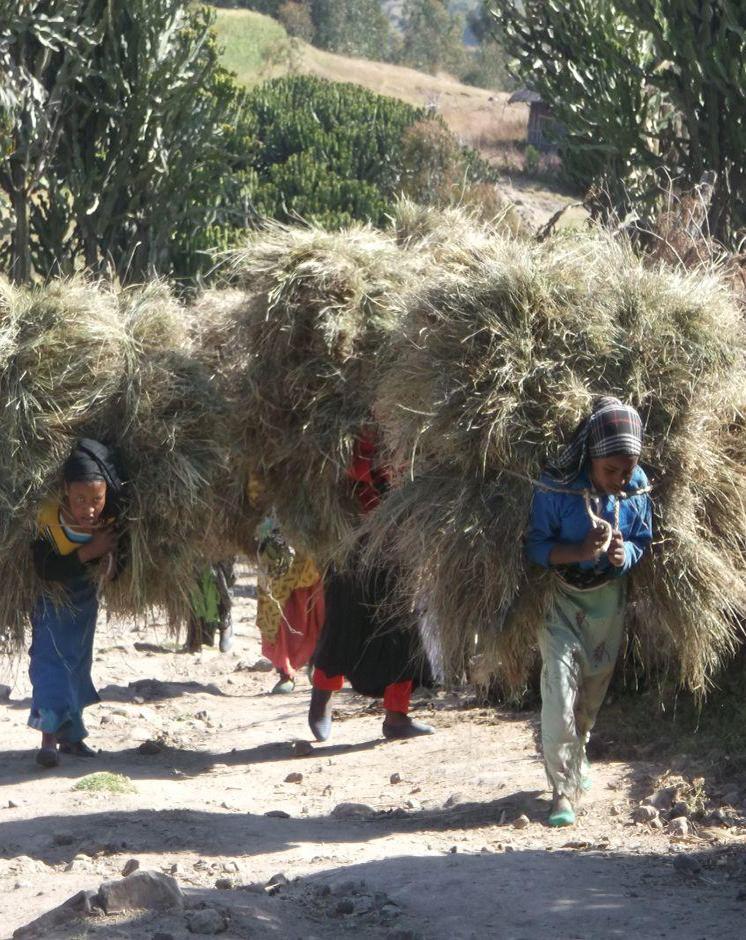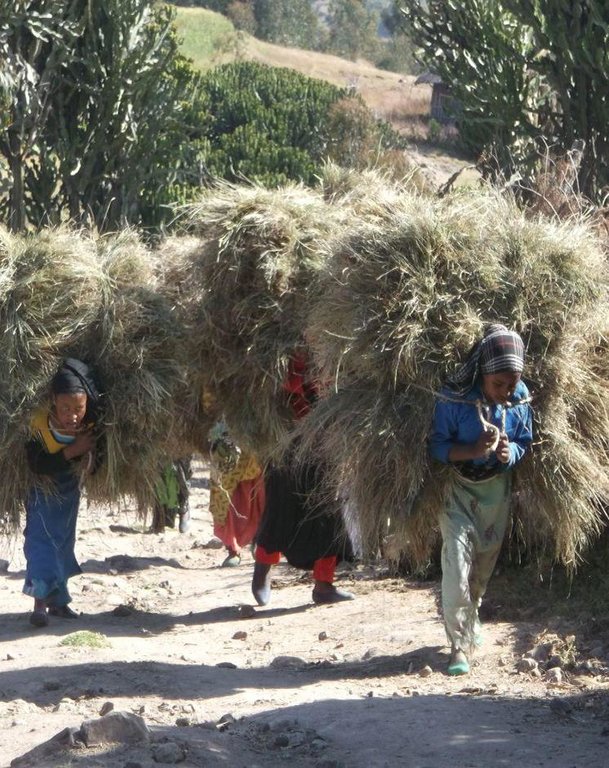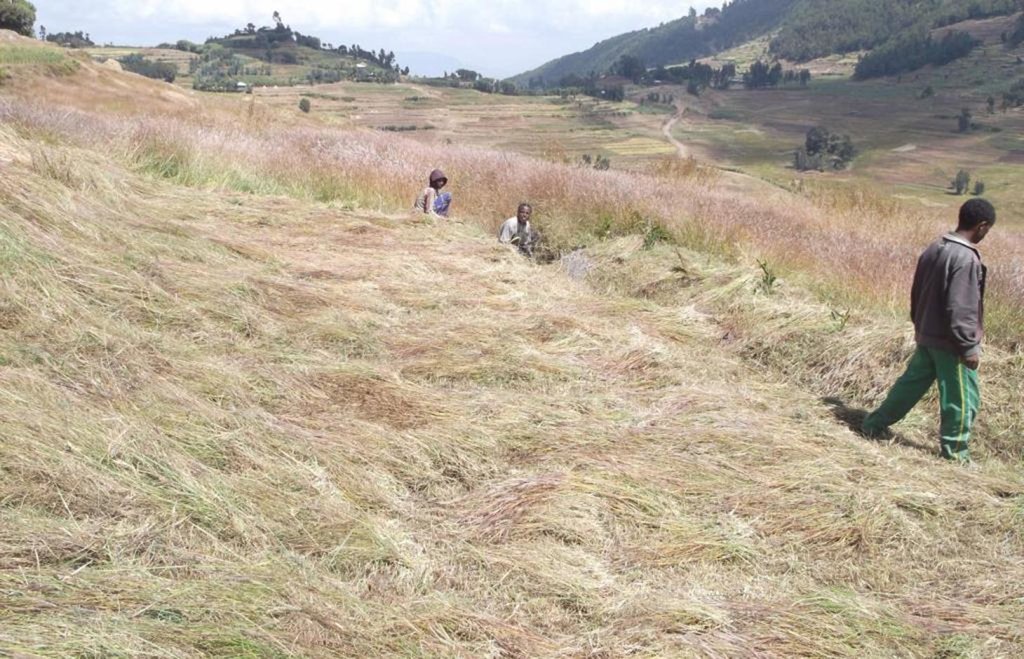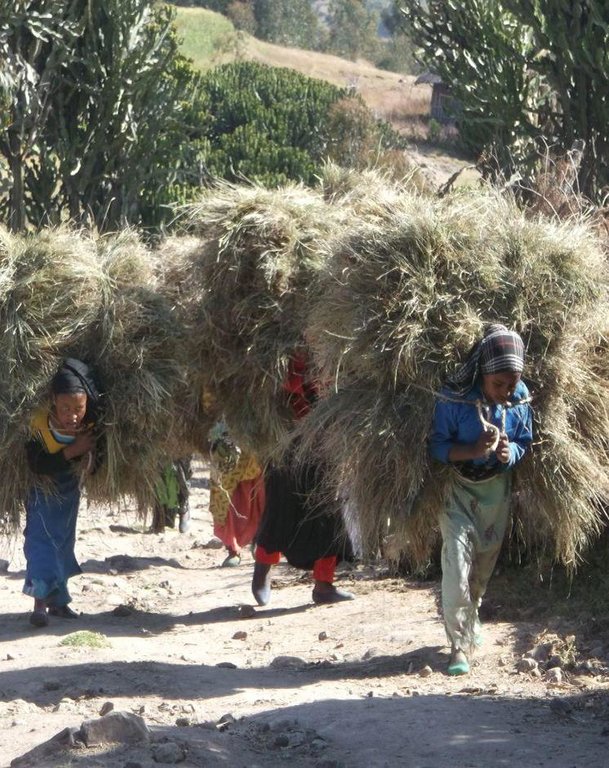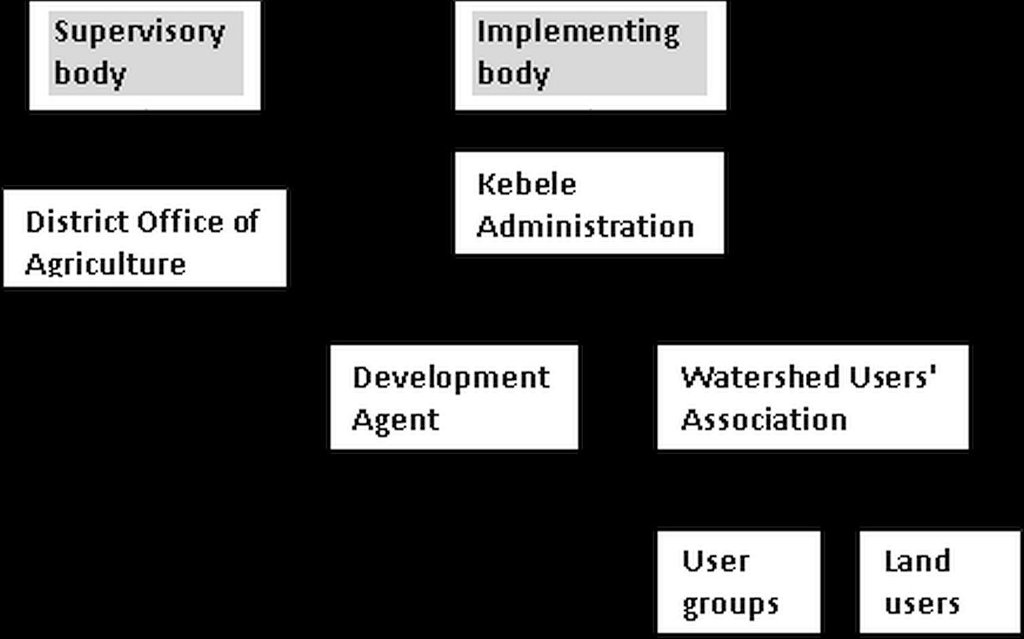'Cut and Carry' Grazing system or 'Zero Grazing' (CCG) [ອີທິໂອເປຍ]
- ການສ້າງ:
- ປັບປູງ:
- ຜູ້ສັງລວມຂໍ້ມູນ: Gizaw Desta Gessesse
- ບັນນາທິການ: –
- ຜູ້ທົບທວນຄືນ: Fabian Ottiger
Ensesa Asro Memgeb (Amharic)
approaches_2497 - ອີທິໂອເປຍ
ເບິ່ງພາກສ່ວນ
ຂະຫຍາຍທັງໝົດ ຍຸບທັງໝົດ1. ຂໍ້ມູນທົ່ວໄປ
1.2 ລາຍລະອຽດ ການຕິດຕໍ່ ຂອງບຸກຄົນທີ່ຊັບພະຍາກອນ ແລະ ສະຖາບັນ ການມີສ່ວນຮ່ວມ ໃນການປະເມີນຜົນ ແລະ ເອກະສານ ຂອງວິທີທາງ
ຜູ້ຊ່ຽວຊານ ດ້ານການຄຸ້ມຄອງ ທີ່ດິນແບບຍືນຍົງ:
Melese Bekure
WLRC
ອີທິໂອເປຍ
ຊື່ຂອງ ສະຖາບັນການຈັດຕັ້ງ ທີ່ອໍານວຍຄວາມສະດວກ ໃນການສ້າງເອກກະສານ ຫຼື ປະເມີນແນວທາງ (ຖ້າກ່ຽວຂ້ອງ)
Water and Land Resource Centre (WLRC) - ອີທິໂອເປຍ1.3 ເງື່ອນໄຂ ຂອງການນໍາໃຊ້ເອກກະສານຂໍ້ມູນ ຂອງ WOCAT
ເມື່ອໃດທີ່ໄດ້ສັງລວມຂໍ້ມູນ (ຢູ່ພາກສະໜາມ)?
16/05/2014
ຜູ້ສັງລວມ ແລະ ບັນດາຜູ້ຕອບແບບສອບຖາມ ຍອມຮັບໃນເງື່ອນໄຂ ການນໍາໃຊ້ຂໍ້ມູນເອກະສານ ທີ່ສ້າງຂື້ນ ໂດຍຜ່ານ ອົງການ WOCAT:
ແມ່ນ
1.4 ເອກະສານອ້າງອີງ (ຫຼາຍ) ກັບແບບສອບຖາມ (ຫຼາຍ) ເຕັກໂນໂລຢີ ຂອງດ້ານການຄຸ້ມຄອງ ດິນແບບຍືນຍົງ
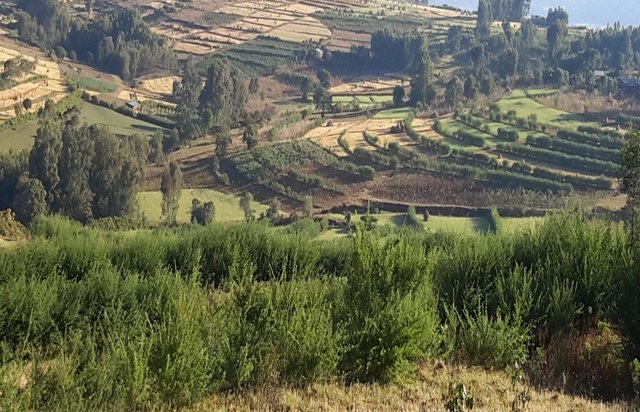
Vegetated graded soil bund [ອີທິໂອເປຍ]
Vegetated graded soil bund is a soil conservation practice meant for cultivated lands and constructed by excavating graded channel on upper side and develop embankment on lower side which is planted with grass or shrub species in order to control soil erosion and drain excess runoff implemented through community mobilization.
- ຜູ້ສັງລວມຂໍ້ມູນ: Gizaw Desta Gessesse
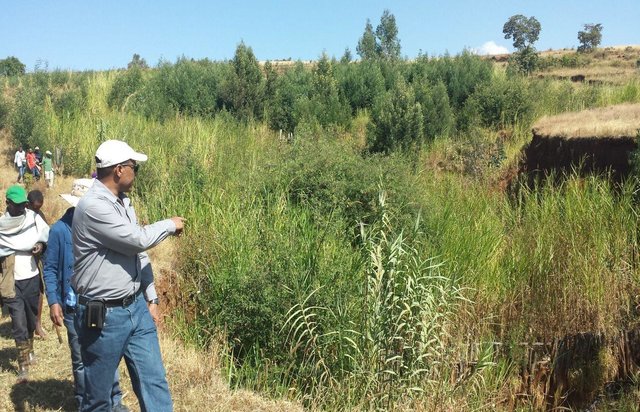
Gully erosion management [ອີທິໂອເປຍ]
Gully erosion management is the application of combination of practices to control excess or concentrated runoff generation in the gully upstream catchment area, divert excess runoff upstream of gully heads and control further development of gully using appropriate structural and vegetative measures in the head, bed and sides of the …
- ຜູ້ສັງລວມຂໍ້ມູນ: Gizaw Desta Gessesse
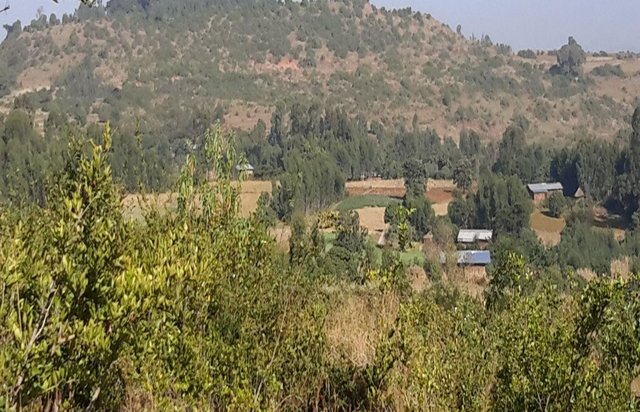
Area closure on degraded lands [ອີທິໂອເປຍ]
Area closure on degraded lands is a land management practice used to rehabilitate and conserve the natural resource bases, and enhance its natural regeneration and restoring capacity and productive functions by excluding animal and human interferences through community consultation and collective actions.
- ຜູ້ສັງລວມຂໍ້ມູນ: Gizaw Desta Gessesse
2. ພັນລະນາ ແນວທາງການຄຸ້ມຄອງນໍາໃຊ້ດິນແບບຍືນຍົງ
2.1 ການອະທິບາຍ ໂດຍຫຍໍ້ ຂອງວິທີທາງ
Cut and carry grazing system (alternatively called zero grazing) is an approach where the community is consulted to identify and agree on areas to be closed and protected from free grazing; establish user groups are established to share the fodder biomass harvested from communal closed areas equitably; they utilize tree/shrub fodder planted on bunds.
2.2 ການອະທິບາຍ ລາຍລະອຽດ ຂອງວິທີທາງ
ການອະທິບາຍ ລາຍລະອຽດ ຂອງວິທີທາງ:
Aims / objectives: Zero grazing aims to reduce the impact of livestock management on land degradation. The objectives are: 1) implement cut and carry grazing system by establishing user groups for equitable share of biomass, 2) increase forage quantity and quality by improving the fodder and grass biomass production per unit area, 3) Protect further soil degradation and vegetation loss
Methods: Cut and carry employs series discussion with community to identify zero grazing sites and set bylaws to implement the approach. The watershed committee together with Development Agents and Kebele administration consult the community to identify and decide on the right beneficiaries of benefits gained from closed communal areas. Once the community agrees on the bylaws, the Kebele unit council approved and passed to district court for endorsement. The watershed committee, now renamed as Watershed Users Association, is the legitimate body authorized to regulate watershed management and benefit sharing among entitled users. The money collected from penalty fee from those who violate the rules use as a revolving fund to be used for other watershed development activities. The beneficiaries organize themselves into groups and they divided the benefits on equaitable basis at every harvest season. The users keep their animals around homes or sheds and feed them on harvested fodder/grass.
Stages of implementation: 1. Consultation and discussion with community in order to identify areas free from livestock access, formulate bylaws, control free grazing, and protect the developed watersheds from livestock interference,
2. Identification and organization of right beneficiaries into user groups who actually used to benefit previously on the selected area and new users that are believed to share the benefit,
3. Undertaking treatment of area closures with biological, structural and land use management measures as well as planting bunds on crop lands with fodder and grass species,
4. Watershed Committee start to implement or enforce the agreed bylaws on those who violate the rules (allow livestock in the protected areas, harvest biomass or cut tree from closed areas by untitled users, etc.),
5. Utilization of the biomass by user group members through equal share of the harvested biomass.
Role of stakeholders: Community: The community was responsible to select closed areas from livestock interference, identify beneficiaries, harvest and utilize the biomass as per the agreement, and respect and comply with the rules/bylaws;
Development agents: Supported the watershed committee in regulating protected areas, provide technical advice in the implementing integrated watershed interventions and subsequent maintenance activities or operations, and provide awareness creation and training about fodder utilization;
Watershed committee/watershed users association: It played the key role in planning, managing the developed watershed and regulate the benefit utilization arrangements. It applies the rules for those who do not comply with;
Kebele administration: The administration was responsible to control and manage the overall activities and supervise the implementation
Command post: Both the district and kebele command post (adhoc committee) is responsible to supervise the activities and solve problems;
Research: research involved to take part in introducing improved technologies that increase biomass production (like improved species with high quality and biomass) and efficiency (harvesting and packaging implements);
Project/WLRC: Provided material and technical support for the planning, implementation and monitoring activities.
Other important information: Cut and carry grazing system is an important intervention in the Ethiopian farming system where livestock and crop farming are mixed and livestock husbandry is means of crop production and household asset. Livestock farming is a subsistence production, which is not yet commercialized.
2.3 ຮູບພາບຂອງແນວທາງ
2.5 ປະເທດ / ເຂດ / ສະຖານທີ່ບ່ອນທີ່ແນວທາງໄດ້ຖືກນໍາໃຊ້
ປະເທດ:
ອີທິໂອເປຍ
ພາກພື້ນ / ລັດ / ແຂວງ:
Amhara National Regional State
ຂໍ້ມູນເພີ່ມເຕີມຂອງສະຖານທີ່:
Bahir Dar Zuria, Mecha, Yilmna Densa, Dessie Zuria
2.6 ວັນທີເລີ່ມຕົ້ນ ແລະ ສິ້ນສຸດ ການຈັດຕັ້ງປະຕີບັດ ວິທີທາງ
ສະແດງປີຂອງການເລີ່ມຕົ້ນ:
2011
2.7 ປະເພດຂອງແນວທາງ
- ພາຍໃຕ້ໂຄງການ / ແຜນງານ
2.8 ເປົ້າໝາຍ / ຈຸດປະສົງຫຼັກ ຂອງການຈັດຕັ້ງປະຕິບັດ ວິທີທາງ
The Approach focused on SLM only
The main objectives of cut and carry or zero grazing is protection of land degradation and loss of vegetation on communal lands and controlling damage on the soil and water conservation measures implemented on watersheds. Specifically, it is to practice cut and carry feeding system by establishing equitable share of biomass among user groups, increase quantity and quality of forage, and protect further degradation of land and loss of vegetation.
The SLM Approach addressed the following problems: The main problems targeted to address by implementing cut and carry or zero grazing approach are: growing challenges of land degradation due to overgrazing and compaction/trampling effects; growing shortage of livestock feed; lack of communal land resource management regulation and actions.
2.9 ເງື່ອນໄຂອໍານວຍ ຫຼື ຂັດຂວາງການປະຕິບັດຂອງເຕັກໂນໂລຢີ / ເຕັກໂນໂລຢີການນໍາໃຊ້ຕາມແນວທາງ
ມີຄວາມສາມາດ / ເຂັ້າເຖິງຊັບພະຍາກອນດ້ານການເງິນ ແລະ ການບໍລິການ
- ເຊື່ອງຊ້ອນ
Inadequate diversification of income from livestock production due to its low carrying capacity of the grazing lands, low input and technology supply as well as low financial capacity of farmers
Treatment through the SLM Approach: Zero grazing approach helps to increase livestock productivity and attain better weight gain for market.
ການກໍ່ຕັ້ງສະຖາບັນ
- ເຊື່ອງຊ້ອນ
Lack of common property management and regulation to share benefits equitably among users. There is reluctance to respect local initiated bylaws to stop free grazing.
Treatment through the SLM Approach: Watershed committee is institutionalized to govern zero grazing implementation procedures and entitle use rights to right beneficiaries in a group.
ກ່ຽວກັບກົດໝາຍ (ສິດນໍາໃຊ້ດິນ, ສິດນໍາໃຊ້ນໍ້າ)
- ເຊື່ອງຊ້ອນ
The existing land ownership, land use rights / water rights moderately hindered the approach implementation Since there is tradition of open access grazing (animals allowed to graze freely) and pasture lands are communally used, this tradition affects the sustainability of the approach. Although there are community bylaws attempted to enforce through the watershed committee, farmers not yet fully practice cut and carry system of grazing. This, because they wanted to maximize the benefit by entitling individual use rights for communal land resources.
ຄວາມຮູ້ກ່ຽວກັບການຄຸ້ມຄອງ ທີ່ດິນແບບຍືນຍົງ, ການເຂົ້າເຖິງການສະໜັບສະໜູນ ທາງດ້ານວິຊາການ
- ເຊື່ອງຊ້ອນ
Lack of immediate feed options and lack of knowledge of improved fodder production and forage utilization.
Low level of understanding about multiple advantages of zero grazing. Degradation of natural resources in the form of compaction, loss of organic matter and soil erosion and damage to grass and plant biodiversity.
Treatment through the SLM Approach: The approach support to build the skill and knowledge of users about the forage production and utilization techniques by research actors as well it enables to understand feed requirement per household.
3. ການມີສ່ວນຮ່ວມ ແລະ ບົດບາດຂອງພາກສ່ວນທີ່ກ່ຽວຂ້ອງທີ່ໄດ້ມີສ່ວນຮ່ວມ
3.1 ຜູ້ມີສ່ວນຮ່ວມ ໃນວິທີທາງ ແລະ ພາລະບົດບາດ ຂອງເຂົາເຈົ້າ
- ຜູ້ນໍາໃຊ້ດິນໃນທ້ອງຖິ່ນ / ຊຸມຊົນທ້ອງຖິ່ນ
The watershed Users Association, kebele administration and development agents
Individual land users has to play role to control free grazing and practice zero grazing. The closed areas are owned in group and need to protect and control in group. The role of men was mainly dedicated to control free grazing activities and involved in harvesting forage. Women were involved in the plantation of vegetative measures, in bunds and area closures, they took care of animals around their homestead, sometimes they transported forage/biomass for livestock. The approach entitled those who do not own animals to share the biomass collected from communal closed areas. They earned cash by selling the biomass harvest for forage purpose.
- ຜູ້ຊ່ຽວຊານ ການນຄຸ້ມຄອງ ທີ່ດິນແບບຍືນຍົງ / ທີ່ປຶກສາດ້ານກະສິກໍາ
They are involved in the planning, support and supervision of the implementation, monitoring and evaluating the implementation
- ອໍານາດ ການປົກຄອງທ້ອງຖິ່ນ
The district agriculture office
- ພະນັກງານຂັ້ນສູນກາງ (ຜູ້ວາງແຜນ, ຜູ້ສ້າງນະໂຍບາຍ)
Decision makers
They play role to enforce the rules and mobilize the community to control free grazing
3.2 ການມີສ່ວນຮ່ວມຂອງຜູ້ນໍາໃຊ້ທີ່ດິນໃນທ້ອງຖິ່ນ / ຊຸມຊົນທ້ອງຖິ່ນໃນໄລຍະທີ່ແຕກຕ່າງກັນຂອງແນວທາງ
| ການລວບລວມ ເອົາຜູ້ນໍາໃຊ້ດິນ ໃນທ້ອງຖິ່ນ / ຊຸມຊົນທ້ອງຖິ່ນ | ໃຫ້ລະບຸ ຜູ້ໃດທີ່ມີສ່ວນຮ່ວມ ໃນແຕ່ລະກິດຈະກໍາ? | |
|---|---|---|
| ການເລີ່ມຕົ້ນ / ແຮງຈູງໃຈ | ບໍ່ມີ | |
| ການວາງແຜນ | ການຮ່ວມມື | The community and individual land users agree to delineate areas closed from free grazing. At this stage land users should involve and agree. |
| ການປະຕິບັດ | ການຮ່ວມມື | land users need to participate and involve actively to control free grazing and practice cut and carry feeding system. |
| ຕິດຕາມກວດກາ / ການປະເມີນຜົນ | ການຮ່ວມມື | Land users are involved in the evaluation and field days. |
| Research | ການຮ່ວມມື | Land users are involved in participatory technology generation and promotion. |
3.3 ແຜນວາດ (ຖ້າມີ)
ການອະທິບາຍ:
The district office of agriculture together with its Kebele unit is the supervisory body for implementing cut and carry or zero grazing approach. The main implementers are the kebele administration, the watershed users' association and development agents. The Watershed Users' Association (WUA) or sometimes called watershed committee is the implementer of the daily activities or operations to manage and regulate developed watersheds and specifically zero grazing approach by enforcing the agreed bylaws. The Kebele administration unit support and manage administrative matters associated to zero grazing while the development agents assist the WUA and user groups on technical issues. User groups and land users are part of the implementation of the processes.
ຜູ້ຂຽນ:
Gesesse, Gizaw Desta (WLRC, P.O.Box 8707, Addis Abeba, Ethiopia)
3.4 ການຕັດສິນໃຈກ່ຽວກັບການຄັດເລືອກເຕັກໂນໂລຢີຂອງການຄຸ້ມຄອງທີ່ດິນແບບຍືນຍົງ / ເຕັກໂນໂລຢີ
ລະບຸ ຄົນທີ່ຕັດສິນໃຈ ກ່ຽວກັບການຄັດເລືອກຂອງ ເຕັກໂນໂລຢີ / ເຕັກໂນໂລຢີ ຈະໄດ້ຮັບການປະຕິບັດ:
- ຜູ້ຊ່ຽວຊານ ຫຼັກດ້ານການຄຸ້ມຄອງ ທີ່ດິນແບບຍືນຍົງ, ມີການຕິດຕາມປຶກສາຫາລືກັບຜູ້ນໍາໃຊ້ທີ່ດິນ
ອະທິບາຍ:
Decisions on the method of implementing the SLM Technology were made by mainly by SLM specialists with consultation of land users
4. ການສະໜັບສະໜູນທາງດ້ານວິຊາການ, ການສ້າງຄວາມສາມາດ, ແລະ ການຈັດການຄວາມຮູ້.
4.1 ການສ້າງຄວາມສາມາດ / ການຝຶກອົບຮົມ
ຜູ້ນໍາໃຊ້ທີ່ດິນ ຫຼື ພາກສ່ວນກ່ຽວຂ້ອງອື່ນໆ ໄດ້ຮັບການຝຶກອົບຮົມບໍ່?
ແມ່ນ
ໃຫ້ລະບຸ ຜູ້ໃດທີ່ໄດ້ຮັບການຝຶກອົບຮົມ:
- ຜູ້ນໍາໃຊ້ດິນ
- ພະນັກງານພາກສະໜາມ / ທີ່ປຶກສາ
- leaders at local level
ຖ້າເປັນໄປໄດ້, ໃຫ້ລະບຸເພດ, ອາຍຸ, ສະຖານະພາບ, ຊົນເຜົ່າ, ແລະ ອື່ນໆ:
Awareness creation is provided to all land users both men and women, development staff and local leaders.
ຮູບແບບຂອງການຝຶກອົບຮົມ:
- ຕົວຕໍ່ຕົວ
- ເນື້ອທີ່ສວນທົດລອງ
- ກອງປະຊຸມ
ໃນຫົວຂໍ້:
Magnitude and extent of land degradation and the impact of livestock pressure on depletion of natural resources. The community was advised to reduce livestock number and to rely on small number of improved breeds supplemented with intensive forage production and treated crop residues. Development staff was involved in trainings about forage production and management. Leaders also took part in trainings and awareness workshops about land degradation and natural resources conservation.
4.2 ການບໍລິການໃຫ້ຄໍາປຶກສາ
ເຮັດຜູ້ໃຊ້ທີ່ດິນມີການເຂົ້າເຖິງການບໍລິການໃຫ້ຄໍາປຶກສາ?
ແມ່ນ
ລະບຸວ່າການສະໜອງ ການບໍລິການ ໃຫ້ຄໍາປຶກສາ:
- ສູນຄົ້ນຄວ້າ
ອະທິບາຍ / ຄວາມຄິດເຫັນ:
Name of method used for advisory service: Participatory Demonstration and Training Extension System (PADETES); Key elements: Training and awareness creation of farmers in Farmer Training Centers (FTC), Provision of inputs and package, and demonstrations on the Farmer Training Centers (FTC) and experience sharing visits, On job training; The method gives high emphasis to training and to some extent practical demonstrations supported with experience
sharing visits but less emphasis to advisory of farmers on site.
Advisory service is quite adequate to ensure the continuation of land conservation activities; The extension system is quite adequate to ensure continuation of activities. The government service is adequate to ensure the implementation. Furthermore, if the newly structured and formulated Watershed Users Association functions well, it is sufficient to regulate the approach and sustain land conservation.
4.3 ສະຖາບັນການສ້າງຄວາມເຂັ້ມແຂງ (ການພັດທະນາອົງການຈັດຕັ້ງ)
ສະຖາບັນ ໄດ້ຮັບການສ້າງຕັ້ງຂື້ນ ຫຼື ໄດ້ຮັບການສ້າງຄວາມເຂັ້ມແຂງ ໂດຍການຈັດຕັ້ງປະຕິບັດ ວິທີທາງບໍ່?
- ມີ, ພໍສົມຄວນ
ລະບຸ ທາງສະຖາບັນ ໄດ້ສ້າງຄວາມເຂັ້ມແຂງ ໃນລະດັບໃດ (ຫຼາຍ):
- ທ້ອງຖິ່ນ
ລະບຸ ປະເພດ ຂອງສະໜັບສະໜູນ:
- ການສ້າງຄວາມອາດສາມາດ / ການຝຶກອົບຮົມ
ໃຫ້ລາຍລະອຽດເພີ່ມເຕີມ:
The support is mainly awareness creation and training. The local institutions like watershed users association, User Groups, Farmer Training Centers are supported by training.
4.4 ຕິດຕາມກວດກາ ແລະ ປະເມີນຜົນ
ການຈັດຕັ້ງປະຕິບັດ ວິທີທາງ ໄດ້ມີການປະເມີນຜົນ ແລະ ຕິດຕາມບໍ?
ແມ່ນ
ຄວາມຄິດເຫັນ:
bio-physical aspects were ad hoc monitored by project staff, government, land users through observations; indicators: Free grazing by animals; land users who practice zero grazing
bio-physical aspects were regular monitored by project staff through measurements; indicators: Forage biomass harvested and shared among the land users
technical aspects were ad hoc monitored by project staff, government, land users through observations; indicators: Fattening practice; change in animal body performance
socio-cultural aspects were ad hoc monitored by project staff through observations; indicators: Formation of User Groups and share of benefits; Conflict reduction; role of actors
economic / production aspects were ad hoc monitored by project staff, government through observations; indicators: Fattening benefits;
area treated aspects were ad hoc monitored by project staff through observations; indicators: Area covered by zero grazing
no. of land users involved aspects were ad hoc monitored by project staff, land users through observations; indicators: Land users who practice zero grazing or who voilate the rules
management of Approach aspects were regular monitored by None through measurements; indicators: Damage to treated areas by free grazing
There were several changes in the Approach as a result of monitoring and evaluation: As a result of monitoring and evaluation the practice of zero grazing is expanded. Strict enforcement of the bylaws brought change in zero grazing practices and some also attempted to reduce their livestock number
There were no changes in the Technology as a result of monitoring and evaluation
4.5 ການຄົ້ນຄວ້າ
ນີ້້ແມ່ນສ່ວນໜຶ່ງ ການຄົ້ນຄວ້າ ຂອງວິທີທາງບໍ່?
ແມ່ນ
ລະບຸ ຫົວຂໍ້:
- ລະບົບນິເວດ
- ເຕັກໂນໂລຢີ
ໃຫ້ຂໍ້ມູນ ເພີ່ມເຕີມ ແລະ ກໍານົດ ຜູ້ໃດເຮັດການຄົ້ນຄວ້າ:
The research support is most of the time in form of on-farm research. Research is part of the approach. The research provides technical backstopping by introducing improved agricultural technologies like improved forage species and breeds that complement the SLM technologies where the approach is designed for.
Research was carried out on-farm
5. ການສະໜັບສະໜູນທາງດ້ານການເງິນ ແລະ ອຸປະກອນຈາກພາຍນອກ
5.1 ງົບປະມານປະຈໍາປີ ສໍາລັບວິທີທາງ ຂອງການຄຸ້ມຄອງ ທີ່ດິນແບບຍືນຍົງ
ຖ້າຫາກບໍ່ຮູ້ຈັດງົບປະມານທີ່ແນ່ນອນ ແມ່ນໃຫ້ປະມານເອົາ:
- 10,000-100,000
ຄໍາເຫັນ (ຕົວຢ່າງ: ແຫຼ່ງຂໍ້ມູນຫຼັກ ຂອງການສະໜອງທຶນ / ຜູ້ໃຫ້ທຶນທີ່ສໍາຄັນ):
Approach costs were met by the following donors: local government (district, county, municipality, village etc) (Through technical and material support and capacity building): 28.0%; local community / land user(s) (For scouting by Watershed Users Association, free labor for implementation, and sometimes wage for guards): 72.0%
5.2 ການສະໜັບສະໜູນ ທາງດ້ານການເງິນ / ອຸປະກອນ ສະໜອງໃຫ້ແກ່ຜູ້ນໍາທີ່ດິນ
ຜູ້ນໍາໃຊ້ດິນ ໄດ້ຮັບການສະໜັບສະໜູນ ທາງດ້ານ ການເງິນ / ອຸປະກອນ ໃນການຈັດຕັ້ງປະຕິບັດ ເຕັກໂນໂລຢີບໍ?
ແມ່ນ
ຖ້າແມ່ນ, ໃຫ້ລະບຸປະເພດ (ຫຼາຍ) ຂອງການສະໜັບສະໜູນ, ເງື່ອນໄຂ ແລະ ຜູູ້ສະໜອງ (ຫຼາຍ):
The inputs like seedlings and grass splits raised in the nurseries for the implementation of vegetative measures and other technologies that support the efficiency and management of the SLM technologies are supported by the government and/or projects.
5.3 ເງິນສົມທົບສໍາລັບການນໍາໃຊ້ສະເພາະປັດໃຈຂາເຂົ້າໃນການຜະລີດກະສິກໍາ (ລວມທັງແຮງງານ)
- ອຸປະກອນ
| ໃຫ້ລະບຸໄດ້ຮັບການສະໜັບສະໜູນປັດໃຈຂາເຂົ້າຫຍັງແດ່ | ທີ່ຂອບເຂດ | ລະບຸ ການອຸດໜູນ |
|---|---|---|
| ເຄື່ອງມື | ງົບປະມານບາງສ່ວນ | Hand tools for construction |
- ກະສິກໍາ
| ໃຫ້ລະບຸໄດ້ຮັບການສະໜັບສະໜູນປັດໃຈຂາເຂົ້າຫຍັງແດ່ | ທີ່ຂອບເຂດ | ລະບຸ ການອຸດໜູນ |
|---|---|---|
| ແນວພັນ, ແກ່ນພັນ | ງົບປະມານເຕັມສ່ວນ | Tree seedlings and grasses |
ຖ້າແຮງງານ ຂອງຜູ້ນໍາໃຊ້ດິນ ໄດ້ຮັບການສະໜັບສະໜູນ ປັດໃຈຂາເຂົ້າ, ແມ່ນບໍ່:
- ການອາສາ
ຄວາມຄິດເຫັນ:
The labor is totally contributed by land users voluntarily through community mobilization approach.
5.4 ສິນເຊື່ອ
ໄດ້ປ່ອຍສິນເຊື່ອ ສະໜອງໃຫ້ພາຍໃຕ້ ວິທີການສໍາລັບກິດຈະກໍາ ການຄຸ້ມຄອງ ທີ່ດິນແບບຍືນນຍົງບໍ່?
ບໍ່ແມ່ນ
6. ວິເຄາະຜົນກະທົບ ແລະ ສັງລວມບັນຫາ
6.1 ຜົນກະທົບຂອງແນວທາງ
ການຈັດຕັ້ງປະຕິບັດ ວິທີທາງ ສາມາດຊ່ວຍຜູ້ນໍາໃຊ້ທີ່ດິນ ໃນການຈັດຕັ້ງປະຕິບັດ ແລະ ບໍາລຸງຮັກສາ ເຕັກໂນໂລຢີ ການຄຸ້ມຄອງ ທີ່ດິນແບບຍືນຍົງໄດ້ບໍ?
- ບໍ່
- ມີ, ໜ້ອຍໜຶ່ງ
- ມີ, ພໍສົມຄວນ
- ມີ, ຫຼາຍ
The approach aim to rehabilitate unproductive and degraded lands and thereby the soil moisture and biomass productivity improve. It also helps to increase the level of awareness to protect and manage communal resources and share of benefits out of it. It also gradually increases the ecosystem services such as increase the duration of flow of streams, increase stream flow and water availability, improve the diversity of plant species, and improve the micro-climatic conditions.
ການຈັດຕັ້ງປະຕິບັດ ວິທີທາງ ສາມາດສ້າງຄວາມເຂັ້ມແຂງ ທາງສັງຄົມ ແລະ ເສດຖະກິດບໍ່?
- ບໍ່
- ມີ, ໜ້ອຍໜຶ່ງ
- ມີ, ພໍສົມຄວນ
- ມີ, ຫຼາຍ
Land users who do not have animals also share the benefit equally with the land users who own animals. Thus, they improve their situation by selling grass biomass for feed. Others also employed to prepare and raise tree and grass seedlings in nurseries.
ການຈັດຕັ້ງປະຕິບັດ ວິທີທາງ ສາມາດປັບປຸງ ປະເດັນການຖືຄອງທີ່ດິນ / ສິດທິໃນການນໍາໃຊ້ທີ່ດິນ ທີ່ເຊື່ອງຊ້ອນໃນການຈັດຕັ້ງປະຕິບັດ ເຕັກໂນໂລຢີ ການຄຸ້ມຄອງ ທີ່ດິນແບບຍືນຍົງໄດ້ບໍ?
- ບໍ່
- ມີ, ໜ້ອຍໜຶ່ງ
- ມີ, ພໍສົມຄວນ
- ມີ, ຫຼາຍ
Forage biomass production and improved forage development were parts of the SLM technologies help to reduce the feed shortage problem. The approach is thus help to improve feed shortage by producing alternative fodder production strategies on bunds, gullies, area closures and backyards while controlling free grazing by implementing community agreed bylaws and setting entitlement to group use rights.
Did other land users / projects adopt the Approach?
- ບໍ່
- ມີ, ໜ້ອຍໜຶ່ງ
- ມີ, ພໍສົມຄວນ
- ມີ, ຫຼາຍ
The cut and carry system is gradually expanded to adjacent watersheds and villages after sharing experiences during field days. Land users become aware of the benefits of cut and carry system on livestock production and health. Experts and leaders from other districts visited the approach and plan to expand to their areas.
Did the Approach lead to improved livelihoods / human well-being?
- ບໍ່
- ມີ, ໜ້ອຍໜຶ່ງ
- ມີ, ພໍສົມຄວນ
- ມີ, ຫຼາຍ
In two years project life, some land users particularly youths involve in apiculture production using the areas closed for zero grazing, and some others practiced fattening using the biomass harvest from area closures and vegetated fodder trees on bunds.
Did the Approach help to alleviate poverty?
- ບໍ່
- ມີ, ໜ້ອຍໜຶ່ງ
- ມີ, ພໍສົມຄວນ
- ມີ, ຫຼາຍ
Cut and carry or zero grazing approach allowed some land users to use improved animal breeds and fattening practices that increase productivity and reduce poverty.
6.2 ແຮງຈູງໃຈຫຼັກຂອງຜູ້ນໍາໃຊ້ທີ່ດິນໃນການປະຕິບັດການຄຸ້ມຄອງທີ່ດິນແບບຍືນຍົງ
- ການຜະລິດເພີ່ມຂຶ້ນ
The Immediate interest is to gain biomass harvest from area closures for livestock production
- ການຊໍາລະເງິນ / ເງິນອຸດໜູນ
Some land users are motivated to gain in kind material support in kind like seeds, seedlings, breed
- ກົດລະບຽບແລະລະບຽບການ (ລະອຽດ) / ການບັງຄັບໃຊ້
Gain benefit through equitable share of benefits from area closures
- well-being and livelihoods improvement
Introduction of fattening and synchronization using improved fodder production for livestock
6.3 ຄວາມຍືນຍົງຂອງກິດຈະກໍາວິທີທາງ
ຜູ້ນໍາໃຊ້ ທີ່ດິນ ສາມາດສືບຕໍ່ ການຈັດຕັ້ງປະຕິບັດ ຜ່ານວິທີທາງໄດ້ບໍ່ (ໂດຍປາດສະຈາກ ການຊ່ວຍເຫຼືອ ຈາກພາກສ່ວນພາຍນອກ)?
- ແມ່ນ
ຖ້າ ໄດ້, ອະທິບາຍເຫດຜົນ:
It can be sustained if adequate technology supply, effective capacity development, and regulatory systems become effective. Additional efforts on increasing the technical skill of farmers and especially for members of Watershed Users Association on regulatory practices by employing continuous awareness creation, training and demonstration activities.
6.4 ຈຸດແຂງ / ຂໍ້ດີ ຂອງວິທີທາງ
| ຈຸດແຂງ / ຂໍ້ດີ / ໂອກາດໃນການນໍາໃຊ້ທີ່ດິນ |
|---|
| The approach give benefit to those who have less power within the community. (How to sustain/ enhance this strength: Strengthen and empower user groups in particular and watershed users' association in general.) |
| Improved body performance of the animals treated in zero grazing. (How to sustain/ enhance this strength: Provide continuous advisory services to land users in order to implement zero grazing and practice fattening.) |
| ຈຸດແຂງ / ຈຸດດີ / ໂອກາດ ຈາກທັດສະນະຂອງຜູ້ປ້ອນຂໍ້ມູນ ຫຼື ບຸກຄົນສຳຄັນ |
|---|
| Increase the attitude and knowledge of land users about land degradation and sustainable land management. (How to sustain/ enhance this strength: Launch continuous training sessions or capacity building activities in the Farmer Training Centers (FTC).) |
|
Degraded lands become rehabilitated and productive and off-site ecosystem services enhanced, and restore the lost plant biodiversity on degraded lands and waste lands. (How to sustain/ enhance this strength: Maintain interventions and comply with agreed bylaws. ) |
|
Strengthen grass root level institutions that govern the management of resources in watersheds. (How to sustain/ enhance this strength: Provide support and increase their technical and financial capacity.) |
|
Communal degraded lands are entitled to organized use rights and gives opportunity to those who do not access benefit from communal lands. (How to sustain/ enhance this strength: Strengthen the Watershed Users Association and user groups.) |
|
Enable to introduce improved livestock production system that improve livestock productivity as a result of controlled feeding and avoidance of long distance movement of animals and gradually change from subsistence to (semi) commercial production. (How to sustain/ enhance this strength: Provide technical support and link to market information and opportunities.) |
6.5 ຈຸດອ່ອນ / ຂໍ້ເສຍຂອງແນວທາງ ແລະ ວິທີການແກ້ໄຂໃຫ້ເຂົາເຈົ້າ
| ຈຸດອ່ອນ / ຂໍ້ເສຍ / ຄວາມສ່ຽງໃນມູມມອງຂອງຜູ້ນໍາໃຊ້ທີ່ດິນ | ມີວິທີການແກ້ໄຂຄືແນວໃດ? |
|---|---|
| Zero grazing applies only when the number of animals per household is minimum while large livestock flock size is required to use for trampling and as a risk aversion mechanisms. | Options of agronomic practices without trampling and other agricultural implements that substitute trampling has to be introduced and adopted. |
| The approach has limitations in areas where there is forage constraints and shortage of communal land for grazing purposes. | Introduce intensive forage production systems (for example backyard) that improve productivity per unit area. |
| ຈຸດອ່ອນ ຫຼື ຂໍ້ເສຍ ຫຼື ຄວາມສ່ຽງ ໃນມຸມມອງຂອງ ຜູ້ສັງລວມຂໍ້ມູນ ຫຼື ບັນດາຜູ້ຕອບແບບສອບຖາມ | ມີວິທີການແກ້ໄຂຄືແນວໃດ? |
|---|---|
| All land users were not equally committed and took accountability. | Motivate and engage them in every decision making process. |
| Inadequate support to watershed committee in enforcing the rules from higher level administrative units. | Establish forums or platforms for discussing challenges and solve problems. |
7. ເອກກະສານອ້າງອີງ ແລະ ຂໍ້ມູນການເຊື່ອມໂຍງ
7.1 ວິທີການ / ແຫຼ່ງຂໍ້ມູນ
- ການໄປຢ້ຽມຢາມພາກສະໜາມ, ການສໍາຫຼວດພາກສະໜາມ
- ການສໍາພາດ ຜູ້ນໍາໃຊ້ທີ່ດິນ
7.2 ເອກະສານທົ່ວໄປທີ່ສາມາດໃຊ້ໄດ້
ຫົວຂໍ້, ຜູ້ຂຽນ, ປີ, ISBN:
Area closure. WLRC Brief No. 2 June 2015
ມີຢູ່ໃສ?ມູນຄ່າເທົ່າໃດ?
www.wlrc-eth.org
ຂໍ້ມູນການເຊື່ອມຕໍ່ ແລະ ເນື້ອໃນ
ຂະຫຍາຍທັງໝົດ ຍຸບທັງໝົດການເຊື່ອມຕໍ່

Vegetated graded soil bund [ອີທິໂອເປຍ]
Vegetated graded soil bund is a soil conservation practice meant for cultivated lands and constructed by excavating graded channel on upper side and develop embankment on lower side which is planted with grass or shrub species in order to control soil erosion and drain excess runoff implemented through community mobilization.
- ຜູ້ສັງລວມຂໍ້ມູນ: Gizaw Desta Gessesse

Gully erosion management [ອີທິໂອເປຍ]
Gully erosion management is the application of combination of practices to control excess or concentrated runoff generation in the gully upstream catchment area, divert excess runoff upstream of gully heads and control further development of gully using appropriate structural and vegetative measures in the head, bed and sides of the …
- ຜູ້ສັງລວມຂໍ້ມູນ: Gizaw Desta Gessesse

Area closure on degraded lands [ອີທິໂອເປຍ]
Area closure on degraded lands is a land management practice used to rehabilitate and conserve the natural resource bases, and enhance its natural regeneration and restoring capacity and productive functions by excluding animal and human interferences through community consultation and collective actions.
- ຜູ້ສັງລວມຂໍ້ມູນ: Gizaw Desta Gessesse
ເນື້ອໃນ
ບໍ່ມີເນື້ອໃນ


